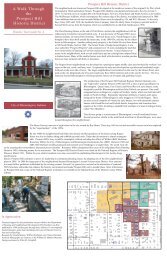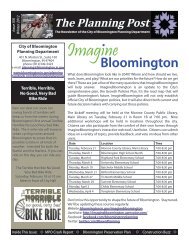Peak Oil Task Force Report - City of Bloomington - State of Indiana
Peak Oil Task Force Report - City of Bloomington - State of Indiana
Peak Oil Task Force Report - City of Bloomington - State of Indiana
You also want an ePaper? Increase the reach of your titles
YUMPU automatically turns print PDFs into web optimized ePapers that Google loves.
About the Activity Nodes Project<br />
In a post‐peak world, it will be important for people to live close to services critical to<br />
everyday life. In an effort to understand just how close or far residents currently live from<br />
key services, the <strong>Task</strong> <strong>Force</strong> mapped those services and compared the location <strong>of</strong> key<br />
services (areas <strong>of</strong> “activity nodes”) against a map <strong>of</strong> population density.<br />
The following Activity Nodes map tracks the location <strong>of</strong> nine key services and the density <strong>of</strong><br />
these services within a 300‐foot by 300‐foot block: grocery stores, schools, pharmacies,<br />
post <strong>of</strong>fices, public libraries, restaurants, hardware stores, department stores and farmers’<br />
markets. The areas <strong>of</strong> the city with the highest concentration <strong>of</strong> these services (seven or<br />
more) are noted in bright pink; those with five to six locations are marked in red; those<br />
with four and three destinations are marked in dark and light orange respectively while<br />
those with one or two locations are indicated by yellow.<br />
While the current picture <strong>of</strong> activity nodes points to three distinct nodes, an ideal<br />
configuration would place people closer to the nodes or the nodes closer to the people. Map<br />
B outlines areas <strong>of</strong> population density. When we lay the services map on top <strong>of</strong> the<br />
population map to examine the ways they align, it is clear that daily necessities cluster<br />
around major thoroughfares and do not necessarily track population density (Map C).<br />
The idea <strong>of</strong> activity nodes is anticipated in the <strong>City</strong>’s 2002 Growth Policies Plan (GPP). The<br />
GPP outlines the idea <strong>of</strong> a “Neighborhood Activity Center” (NAC). A NAC is a “mixed<br />
commercial node that serves as the central focus <strong>of</strong> each neighborhood” that should be<br />
easily accessible by pedestrians and minimize auto traffic while providing “small‐scale<br />
retail and business services within the context <strong>of</strong> neighborhoods” 134 However, the GPP<br />
identified just a handful <strong>of</strong> NACs, only a few <strong>of</strong> which map onto the critical nodes identified<br />
by the <strong>Task</strong> <strong>Force</strong>. 135 For the most part, the NACs identified by the GPP do not align with<br />
critical services, nor are they located in areas <strong>of</strong> significant population density.<br />
134 GPP, 33.<br />
135 Ibid.<br />
<strong>Report</strong> <strong>of</strong> the <strong>Bloomington</strong> <strong>Peak</strong> <strong>Oil</strong> <strong>Task</strong> <strong>Force</strong><br />
96









